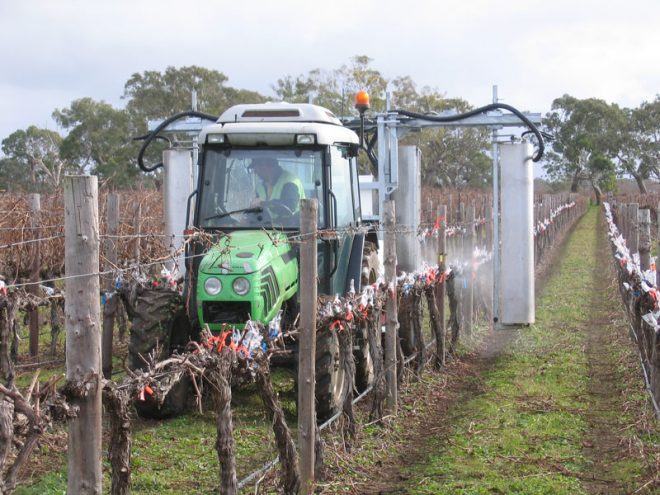Eutypa dieback and botryosphaeria dieback are major grapevine trunk diseases that threaten the sustainability of Australian vineyards. Causal fungi infect pruning wounds and colonise wood, causing dieback and vine death (Wine Australia, 2016).
Vinehealth Australia fully understands that many growers are facing a current battle in managing these trunk diseases. Vinehealth’s Technical Manager Suzanne McLoughlin attended SARDI researcher Dr Mark Sosnowski’s presentation on current and future work on trunk diseases in Coonawarra on 22 March. Here she shares some of the ongoing work on eutypa dieback and botryosphaeria dieback.
Research led by SARDI in collaboration with the National Wine and Grape Industry Centre, with funding from Wine Australia and industry, has focussed on developing practical management strategies for grapevine trunk diseases. High level findings are presented below on the final report of this latest work, entitled ‘Practical Management of Grapevine Trunk Diseases’ (SAR 1205), from February 2017.
Practical strategies for management of the grapevine trunk diseases eutypa and botryosphaeria dieback have been enhanced by new knowledge gained in this project:
- DNA-based molecular tools were developed to detect inoculum from spore traps, and showed that spore dispersal patterns vary in regions with different climates, highlighting the role of rain and the presence of inoculum over the entire year.
- Pruning wounds were highly susceptible to infection for the first two weeks, regardless of the pruning time, with susceptibility decreasing thereafter at various rates, depending on the pathogen.
- The application of the fungicides pyraclostrobin (Cabrio), fluazinam (Emblem) and tebuconazole (Folicur) to pruning wounds within six days of infection, controlled trunk disease pathogens for a total period of up to three weeks.
- In the short-term, remedial surgery was successful for control of botryosphaeria dieback on own-rooted vines, with further work required to improve regeneration of scion material on reworked grafted vines.
- Cultivar susceptibility to dieback varies, with potential for tolerance identified in some germplasm, and preliminary evidence of reduced susceptibility in some clones and rootstocks warrants further investigation.
- Increased water stress generally decreased the susceptibility of canes to colonisation by trunk disease pathogens, suggesting that drought and deficit irrigation practices are not likely to contribute to an increased prevalence of grapevine trunk disease in Australian vineyards.
These outcomes provide new information that is leading to adoption of improved strategies for managing trunk diseases. A newly commenced project, jointly funded by Wine Australia and a number of grapegrowing regions including the Limestone Coast, Clare, Barossa, Adelaide Hills and McLaren Vale, in January 2017 on ‘Grapevine trunk disease management for vineyard longevity in diverse climates of Australia (SAR 1601)’ will build on findings of the work above and ensure trunk disease research and management stays front of mind for growers. This research will particularly focus on:
- Spore trap work:
- Continue surveillance of inoculum dispersal in the field and develop climate specific recommendations to minimise infection.
- Pruning wound work:
- The ability of fungicide adjuvants to maximise wound coverage.
- Critical timing of biocontrol application.
- Remedial surgery:
- Gathering results on the medium-term effectiveness of botryosphaeria dieback management using remedial surgery.
- Susceptibility to dieback:
- Investigation into clonal and rootstock susceptibility.
- Nursery management:
- Establishing infection thresholds in propagation material that may lead to subsequent disease symptoms.
For further information on Eutypa Dieback refer to:
- ‘Best practice Management Guide on Eutypa’ published by Wine Australia and written by Dr Mark Sosnowski https://research.wineaustralia.com/wp-content/uploads/2016/06/20160621_Eutypa-dieback-best-practice-management-guide.pdf
- ‘Managing Eutypa Dieback Grower Resource Kit’ including a video series and Factsheets compiled by Clare Region Winegrape Growers Association, supported through the Wine Australia Regional Program for SA North.
- Video: https://www.youtube.com/playlist?list=PLkCOgHvMxJvjrkytnA5pqVvZxAjNWTDtZ
- Factsheet 1 – Identification and Disease Cycle
https://www.claregrapegrowers.com.au/images/Fact_sheet_1_769kB.pdf - Factsheet 2 – Disease Management
https://www.claregrapegrowers.com.au/images/Fact_sheet_2_631kB.pdf - Factsheet 3 – Case Study: Taylor’s Wines
https://www.claregrapegrowers.com.au/images/Fact_sheet_3_791kB.pdf
- Factsheet and video on ‘Experiences with Eutypa dieback’ produced by the McLaren Vale, Adelaide Hills and Langhorne Creek regions.
- Factsheet 4 – Experiences with Eutypa Dieback https://www.claregrapegrowers.com.au/images/Fact_sheet_4_726kB.pdf
- Video: https://research.wineaustralia.com/resources/experiences-with-eutypa-dieback/
- Contact Dr Mark Sosnowski, South Australian Research and Development Institute (SARDI)
- Email: sosnowski@sa.gov.au
- Phone: 08 8303 9489
References:
- Wine Australia (2016). Grapevine trunk disease management for vineyard longevity in diverse climates in Australia (SAR 1601). https://www.wineaustralia.com/research/strategy-4-improving-resource-management/biosecurity,-pest-and-disease-management/sar-1601
- Wine Australia (2017). Practical Management of Grapevine Trunk Diseases (SAR 1205). https://www.wineaustralia.com/getmedia/8937f16f-d2a8-4152-947d-6a9ca873feab/Final-Report-SAR-1205_1
